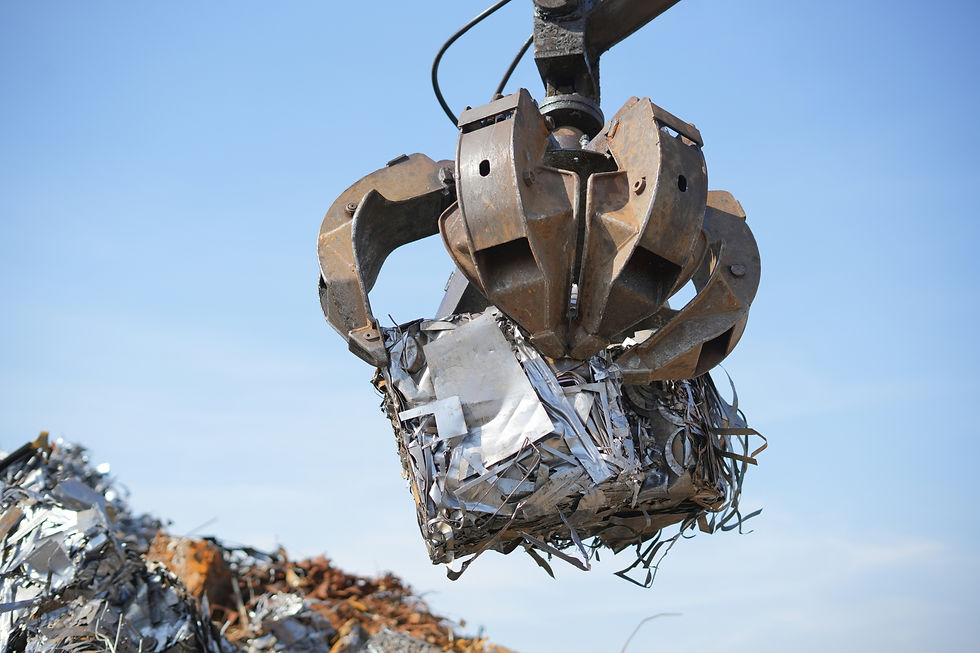How to Tell If Your Excavator Part Can Be Repaired or Needs Replacing (Assessing Wear and Tear with Confidence – Backed by Vikfin’s Expertise)
- RALPH COPE

- Apr 24
- 4 min read
Updated: Apr 28

Whether you're managing a fleet or running a single excavator, equipment downtime is more than an inconvenience — it’s a costly disruption. One of the key decisions you'll face is knowing when a part can be repaired versus when it needs to be replaced altogether.
At Vikfin, we know the challenges our customers face in the field. We specialize in helping businesses make smart, cost-effective decisions with our in-depth knowledge of excavator components and our wide range of high-quality parts.
In this blog, we’ll help you confidently assess wear and tear on your equipment and know when it’s time to call in the experts.
1. Understanding Wear and Tear: What to Look For
Excavators operate in some of the harshest environments, and over time, even the most rugged parts degrade. Knowing what to look for can save you thousands in downtime and unnecessary replacements.
Hydraulic Hoses and Fittings
Signs of Repairable Damage: Minor surface abrasions, small pinhole leaks (if temporary fix is needed).
Signs for Replacement: Cracks, deep abrasions, bulging, or leakage near fittings — these indicate weakening under pressure.
Bucket Teeth and Edges
Signs of Repairable Damage: Slight wear or dull edges may be sharpened.
Signs for Replacement: Rounded or broken teeth, or visible cracks — these severely affect digging efficiency.
Pins and Bushings
Signs of Repairable Damage: Slight wear that doesn’t affect pin fit.
Signs for Replacement: Excessive play, egg-shaped holes, or broken welds.
Undercarriage Components
Signs of Repairable Damage: Minor wear on rollers or track pads.
Signs for Replacement: Broken sprockets, worn rails, or uneven track tension — especially if components wear at different rates.
Hydraulic Cylinders and Seals
Signs of Repairable Damage: Leaking seals or damaged wipers.
Signs for Replacement: Scoring on the cylinder rod, bent rods, or corrosion in the barrel.
Control Valves and Pumps
Signs of Repairable Damage: Minor internal leakage or pressure drop that can be resealed.
Signs for Replacement: Severe internal damage, loss of performance, or contamination beyond repair.
2. Cost Analysis: The Repair vs. Replace Equation
Repairing is often cheaper upfront — but not always in the long run. Here’s what you should consider:
Total cost of repair (parts + labor + downtime)
Frequency of failure — is this the second or third time?
Impact on machine performance — is it operating at full capacity?
Availability of replacement parts — sometimes repairs take longer due to part delays
Warranty — many new parts come with guarantees that repaired components do not
Pro tip from Vikfin: A general rule is, if the repair costs more than 50% of a new part, replacement is often the better long-term investment.
3. Why Diagnosing Early Matters
Early diagnosis is the difference between a minor fix and a major headache. A worn pin today could mean a damaged boom tomorrow. Here’s why it pays to be proactive:
Reduces overall operating costs
Extends the life of neighboring components
Improves machine reliability
Avoids emergency downtime
Many of our clients have saved thousands just by having their equipment routinely inspected by Vikfin’s technicians. Our detailed evaluations often catch issues others miss — before they become budget-busting problems.
4. Vikfin’s Approach to Repairs and Replacements
What sets Vikfin apart is our holistic approach to equipment health. We don’t just look at the part — we consider the whole system and how it interacts with other components.
We offer:
Comprehensive on-site inspections
Precision diagnostic tools to detect internal wear
Expert consultations based on machine usage, environment, and workload
OEM and aftermarket parts options — depending on budget and application
Rapid turnaround to minimize downtime
From routine checks to emergency part sourcing, we’re with you every step of the way.
5. Preventative Maintenance: The Key to Longevity
Preventing damage is always better than repairing it. Our team at Vikfin can help you set up a preventative maintenance program that includes:
Scheduled inspections
Replacement interval tracking
Fluid and filter checks
Undercarriage assessments
Wear-part monitoring
You’ll never miss a service window again — and your machine will run like new for longer.
6. Real Results, Real Customers
“Vikfin helped us avoid a costly hydraulic pump failure by diagnosing seal wear early. Their expertise saved us both money and time.” – Jackson R., Earthmoving Contractor
“I thought we’d have to replace the entire track system, but Vikfin showed us which parts could be rebuilt and which to swap. Great service and honest advice.” – Priya M., Construction Fleet Manager
We pride ourselves on providing transparent advice. If it can be fixed, we’ll fix it. If replacement is the smarter option, we’ll help you find the best part at the right price.
7. Final Thoughts: When in Doubt, Talk to Vikfin
You don't have to be a mechanic to make the right call — you just need a trusted partner. Vikfin is here to help you assess damage, reduce operating costs, and keep your excavator running at peak performance.
Have a part you’re unsure about? Let us take a look — we’ll help you make the smart call.
📞 Contact Vikfin today for a free diagnostic consultation.📧 Email us at admin@vikfin.co.za or visit www.vikfin.co.za
#ExcavatorMaintenance #HeavyMachineryTips #Vikfin #EquipmentRepair #ConstructionLife #DieselMechanic #ExcavatorParts #MachineDowntime #HydraulicRepair #PreventativeMaintenance #FleetManagement #WearAndTear #TrackSystemCare #ExcavatorLife #ConstructionGear #HydraulicSystem #RepairOrReplace #EarthmovingEquipment #EquipmentExperts #MachineCare








Comments